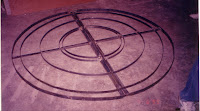
In the book, ‘(Symbolism, 1971)’ it was theorized that there are three categories that can be classified as particular element of symbols. There are Conventional, Accidental and Universal. Conventional symbol was the words that stand or to replace something. Looking to accidental symbol, it has the personal features and the universal symbol was something that was based on someone’s experience or the person that understand it because of having the same experience (Chadwick, Charles, 1971)
To me, representational qualities are most often often summed up into signs and symbols, simplified language of associations either in the form of images or iconic symbols. Looking at the local art scene, the employment of signs and symbols in public artworks are not very apparent, though many artists had explored this iconographic language since the post independence era but it was seldom found in sculpture or public artwork.
Let's imagine the scenario, when signs and symbols take hold on an artist's creative process, the typical initial ideation should manifest from countless illustrations playing profusely in the artist's mind, it later becomes a recognised symbol as the artist tries really hard to make sense of the form derived from his/her imagination, the 'found' symbol was then modified to either make a prosaic mathematical sign or perhaps certain heraldic figures or signatures or completely a new kind of form derived from nature and later simplified to profess a sign or symbol exclusively understood by the artists and later was made known to the public thus shared with his/her audience.
'Signs, symbols, emblems and signals in all their diversity are penetrating and deeply marking expressions of our times, pointing to the future by comprising and conserving something of the past.'
Epilogue, Signs and Symbols, Adrian Frutiger, Watson Guptill
I am interested into marrying the two concepts of signs and symbols into one since I discovered that the two elements intertwined and complemented each other rather tremendously. To my advantages, I discovered that most reference books and literature materials grouped these two titles together.
My actual concern is really on the content of the sculpture I intend to study, and signs and symbols are the recognizable tools available for me to fully synthesize the meaning of the studied sculpture.
From my initial observation, there exist instances of local authorities commissioning public sculpture without philosophical and artistic consideration resulting to an incidental phenomenon of unsightly view to the general public.
To be continued.......



















